Best wildlife photography cameras 2024
Here are our best wildlife photography cameras for shooting in your backyard, on safari, and anywhere in-between

The best wildlife photography cameras won't turn you into an award-winning animal photographer overnight, but they are perhaps the most essential part of this genre of photography and can get you well on your way to becoming one.
In many areas of photography, the lens is usually the star of the show with the camera playing second fiddle. When it comes to taking pictures of animals, though, you'll need to prioritize the best wildlife photography cameras for the specialist autofocus systems and shooting speeds that are needed for wildlife photography.
Of course, you can use any camera — even a camera phone — to photograph a fixed subject. Wildlife, on the other hand, has a tendency to move around, especially when photographers enter their territory. Therefore, having the best wildlife photography cameras made specifically for the job is essential. To go a step further, having a pair of the best binoculars would also be incredibly beneficial for wildlife photography.
If, however, you're more into stargazing than bird watching, we've also got a guide to the best astrophotography cameras that you should check out too - there is even a camera that features on both our lists if you need something to pull double duty — check out our review of the Nikon D850.
If you need a machine to edit your wildlife photos on, you can also check out our guide to the best laptops for photo editing.
Best wildlife cameras: Bridge cameras
If you're a newcomer to photography, and especially wildlife, one of the best ways to get started is with a bridge camera. These combine the handling of a DSLR, the convenience and ease of a compact camera, and the range of a superzoom lens.
The result is an all-in-one package that gives you a greater zoom range than you could achieve with a DSLR or mirrorless camera setup that costs thousands – but the tradeoff is image quality, as bridge cameras use much smaller image sensors, and the AF systems aren't as advanced as more expensive cameras.
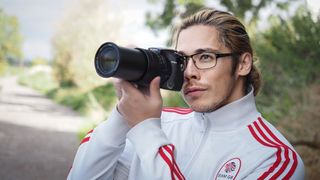
Specifications
Reasons to buy
Reasons to avoid
The Sony Cyber-shot RX10 IV has everything you could ask of a bridge camera – and just about everything you could ask for if you're taking your first foray into wildlife photography, too. At its heart is a powerful one-inch sensor, offering excellent image quality for stills and video alike.
That's made possible by the 24-600m f/2.4-4 lens, which is fast enough to keep you shooting at top speed in most conditions. That means up to 24fps, with dependable phase detect autofocus that keeps up with the action. Its 4K video is crisp and clean, with well controlled rolling shutter (the "Jell-O effect" when panning back and forth, which warps vertical lines).
The downside is that this technology comes with a fairly hefty price tag, though one that won't even buy you the camera body alone of some of the cameras later down this list.
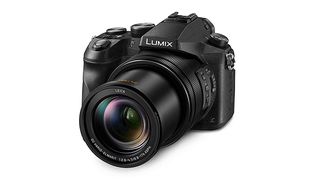
2. Panasonic Lumix FZ2500
Specifications
Reasons to buy
Reasons to avoid
Though the FZ2500 is a slightly older model at this point, it remains a powerful camera and an attractive option for entry level wildlife shooting – and being an older product means that it comes with a very competitive price tag as well.
It lags behind the RX10 IV in a few areas, with its 24-480mm focal range not being quite as long, its aperture being a smidge slower at f/2.8-4.5, and the burst rate being about half. On top of that, the contrast detect-powered AF system isn't as precise or sticky as Sony's.
All that said, it is notably smaller and better to handle, the touchscreen functionality is superior, it has a built-in neutral density filter, and it offers plenty of options for video shooters, with a log profile and the option for 10-bit 4:2:2 (available via an external monitor). Oh, and did we mention that it's significantly cheaper?

Specifications
Reasons to buy
Reasons to avoid
The Nikon Coolpix P1000 is about one thing, and one thing only: range. It offers a frankly absurd 24-3000mm zoom range – to put that into perspective, that's enough to shoot frame-filling shots of the moon. Which means that, whether you're on safari or photographing birds at the local lake, nothing is going to be too far away.
For some people, that reach alone makes this camera worthwhile. The compromises, however, are important to consider. Firstly, the P1000 possesses the smallest and lowest resolution image sensor on this list – so image quality and low light performance take a hit. The AF system and continuous shooting speeds aren't designed for fast action, either, so this is a camera best used for photographing still subjects rather than, say, birds in flight.
Still, that reach. It's impossible to achieve that on a DSLR or mirrorless camera, so if all you want is basically a telescope that takes pictures, it's right here.
- Check out our full Nikon Coolpix P1000 review.
Best wildlife cameras: DSLRs
If you're already a seasoned shooter, it's time to look at a dedicated DSLR that caters to the speed and accuracy required of more advanced wildlife photography. These interchangeable lens cameras pack the pixels, burst rate and buffer depth to make sure you never miss a shot – and the APS-C sensors of the first two options will increase the effective focal length of your lenses by up to 1.6x, getting you even closer to your subjects.
While DSLRs feature blackout-free shooting and huge battery life, they are big, bulky, and the mirror mechanism is loud – making it easy to scare wildlife that's easily spooked.
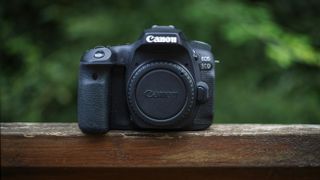
Specifications
Reasons to buy
Reasons to avoid
The perfect Canon APS-C camera for wildlife, the EOS 90D replaces two of the manufacturer's former favorites: the 80D and 7D Mark II. Its pixel-packed 32.5MP sensor is the highest resolution APS-C sensor on the market, giving you greater detail as well as the headroom to crop into your pics – great for artificially 'extending' the length of your lenses as you can still fill the frame with your subject.
Canon's APS-C format has a 1.6x crop factor, which means that your lenses benefit from a 1.6x boost to their focal length. So if you were to mount a 100-400mm optic, it would become an effective 160-640mm. And not only can you natively mount Canon's full frame EF lenses, you can also make use of the EF-S optics that are specifically designed for APS-C cameras.
Its speedy 10fps shooting is offset somewhat by the limited buffer depth, though you shouldn't bump into this too much unless you do a lot of spray and pray. It also boasts uncropped 4K video and a fully articulating touchscreen, making it a breeze to shoot using live view in any orientation.
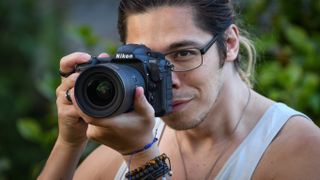
Specifications
Reasons to buy
Reasons to avoid
Nikon's tagline for this camera is "Flagship power, DX agility", as the D500 packs similar performance to the top tier Nikon D6 professional camera, but squeezes it into the form factor of a DX (APS-C) body. The result is an incredibly capable system, albeit one that comes with a couple of compromises.
The 20.9MP resolution looks a little anaemic next to the D500's opposite number, the 32.5MP Canon EOS 90D, but the reduced pixel count produces a dramatically increased buffer depth of 200 RAW images. The D500 also boasts dual memory card slots, one SD and one XQD / CFexpress – though note that the latter, while a newer, faster and more robust format, is considerably more expensive than SD.
The other main downsides with the D500 are that the impressive phase detect AF is replaced by the slower and less reliable contrast detect system when shooting in live view, and shooting in 4K invokes a horrendous 1.5x crop – and that's on top of the existing 1.5x crop factor of Nikon's APS-C sensor, meaning that this is a far from ideal camera for filming video.
- Check out our full Nikon D500 review.
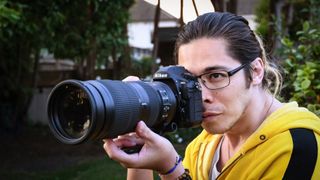
Specifications
Reasons to buy
Reasons to avoid
Not only is the D850 Nikon's best all-round DSLR, it's the best all-round DSLR period. With its ultimate full-frame image quality combined with fast (though not lightning-fast) speed, this full-frame camera is the tool of choice for many advanced amateurs and professionals alike.
Its 45.7MP resolution enables you to capture shots in jaw-dropping detail, or to crop into your images and fill the frame if your lenses haven't quite got enough reach. The pixel-dense sensor also gives you full-frame 4K video, though sadly shooting in live view (whether for stills or video) means that you lose the fantastic phase detect autofocus and are instead stuck with subpar contrast-detect.
The 7fps burst rate is the joint slowest of all cameras on this list (being the same as that of the Nikon P1000), but it can be boosted to 9fps if you attached the battery pack. That adds to the already significant cost of this camera, but if you're looking for the most complete DSLR then the D850 is your best bet.
Best wildlife cameras: Mirrorless cameras
Mirrorless cameras are the next evolution of imaging technology. As the name suggests, they ditch the bulky and noisy mirror mechanism of DSLRs – which makes them not only significantly smaller and lighter, but also enables them to shoot absolutely silently.
No more scaring away a subject when you click the shutter! Not only are their electronic shutters silent, they also operate much faster than their mechanical counterparts. Some of these mirrorless cameras can hit 30 and even 60 frames per second!
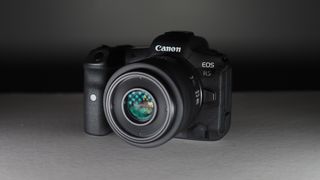
Specifications
Reasons to buy
Reasons to avoid
If we had to choose one camera with which to photograph wildlife, it would hands-down be the Canon EOS R5. This is chiefly because of its incredible autofocus system, which is easily the best on the market right now – especially when it comes to photographing animals, where it is capable of body, face and eye detection.
On paper, Canon only claims that the R5 can track dogs, cats and birds. In our testing, though, there hasn't been a single animal it couldn't recognize, track and lock onto. Lions, monkeys, turtles, iguanas, fish, skunks, meerkats, raccoons, sand squirrels, gophers, seals, Fennec foxes… if it's got a face and eyes, the R5 will put an AF point on it.
Best of all, it can shoot 45MP images at up to 20fps with full face and eye detection – and it can do so silently, so as not to frighten your subjects. Then there's the phenomenal 8K 30p; even if you don't shoot video, this is brilliant for stills as well, as you can extract a 35MP still frame from your footage, effectively giving you up to 30fps shooting as well. Just beware of the 4KHQ and 8K video recording limits, as the R5 is rather infamous for its overheating issues.
- Check out our full Canon EOS R5 review.
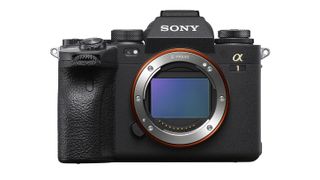
8. Sony A1
Specifications
Reasons to buy
Reasons to avoid
Quite simply, if you want the most powerful camera on the planet, the Sony A1 is it. Its monstrous, full frame, 50.1MP image sensor is stacked, meaning that it has a complex construction that enables ultra-fast readout speeds – producing an astonishing 30 frames per second burst shooting at full resolution.
There is a caveat to this, however. The A1 isn't always able to maintain that 30fps shooting when it comes to tracking subjects – which is compounded by the Animal AF which is good, but not as cheat code-good as that of the Canon EOS R5 or R3. And Sony's new Bird AF, introduced on this camera, isn't very reliable at all – so be prepared to have to do some of the heavy lifting yourself, if you're birding.
While it trumps the R5 when it comes to video, since the overheating issues are much better controlled, it only has a tilting screen rather than a fully articulating one, which isn't optimum for shooting photos or video in live view. Still, a few minor hiccups aside, this is a phenomenally powerful camera that gives you unparalleled specs – though sadly, it comes with an unparalleled price tag.

Specifications
Reasons to buy
Reasons to avoid
Micro Four Thirds cameras may not be your first thought when considering a wildlife camera, but there are many good reasons to look at the E-M1X. For starters, while it has a pro DSLR form factor, its smaller sensor means that lenses are much smaller, lighter and less expensive – meaning you have a smaller and lighter load to carry.
This is aided by the 2x crop factor or the sensor size, which means that you double effectively the focal length of your lenses – so if you're shooting on a 300mm lens, you immediately get a 600mm equivalent field of view. So if you get the M.Zuiko 300mm f/4 with a 2x teleconverter, you have a 1200mm lens – and with the E-M1X's Sync IS technology, the camera and lens stabilization systems work in tandem, meaning that you can shoot tock-solid stills and video handheld, without a tripod.
The camera shoots an astonishing 60fps with focus locked off, or a still-impressive 18fps with full AF/AE tracking. Its best trick for wildlife shooters, however, is Pro Capture; this starts buffering shots when you half-press the shutter, meaning that even if you're a fraction too late with your trigger finger, you've got the 15 frames before you fully depressed the shutter – meaning you never miss a shot, even when you miss it! We've taken E-M1X on safari, and it enabled us to get shots that we simply would have missed otherwise.
- Check out our full Olympus OM-D E-M1X review.
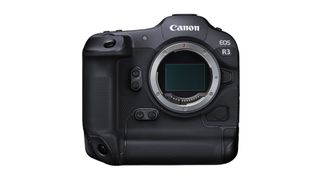
10. Canon EOS R3
Specifications
Reasons to buy
Reasons to avoid
The newest and most advanced camera on this list, the Canon EOS R3 is its top-tier professional mirrorless camera – and it's loaded with features that will be music to the ears of wildlife shooters. While it matches the Sony A1's 30fps burst shooting (and surpasses its buffer depth), its 24.1MP images are lower resolution than the 50.1MP shots from the Sony. That said, the A1's 30fps frame-rate tends to fluctuate, while our experience with the R3 gave us true 30fps performance no matter what we were shooting.
One thing the R3 has that no other camera can match is its Eye Control AF, which uses 8 low-power infrared LEDs in the viewfinder to map and track your eyeball. Once calibrated, all you have to do is look at your subject and the R3 puts the focus point on it – then you just half-press the shutter, the AF kicks in, and you shoot! This isn't intended for fast-moving subjects like birds, but if you're shooting a group of animals and you want to quickly focus on a specific one, this is the fastest way to move your focus points.
If that sounds a bit too Star Trek for you, the R3 has the same ghostly good animal AF system as the Canon EOS R5 above, so you get the same level of near-magic performance. Throw in 6K 60p RAW video and an optical smart controller that's faster than a joystick, this is a camera that's designed for premium performance.
What is a wildlife camera?
So what makes the best wildlife cameras different from regular cameras? As noted, they typically offer formidable autofocus that is designed to keep up with the fast-twitch, erratic nature of wild animals.
A standard camera should be able to handle portraits and landscapes no problem, as this isn't very taxing on the focusing system. Point it at a bird in flight, however, and it will likely struggle to keep the subject in focus. In fact, even very expensive cameras can struggle to focus on animals – or at least, to focus on the part of the animal that you want.
This is where phase detect autofocus, which is superior to contrast detect, comes into play. Taking things to the next level, however, are subject detection algorithms and Animal AF; using deep learning and artificial intelligence, a new breed of mirrorless cameras can actually recognize birds and wild animals, automatically track them, and even place the focus point on their faces and eyes!
The other key feature possessed by the best wildlife cameras are their ferocious shooting speeds (measures in frames per second, or fps). Think of a cheetah running at top speed; you need to capture as many photographs as possible to ensure that you get the precise moment you want – and also to make sure that at least some of your shots are in focus! Associated with this is the camera's buffer depth, meaning how many shots it can take in a single burst without having to stop and think.
Many cameras intended for wildlife shooting are also weather-sealed, meaning that they are resistant to rain, dust and other elements you may encounter in the field.
What else do you need for wildlife photography?
While getting the right camera is crucial, this isn't to say that the lens doesn't matter – far from it! You will, of course, need a suitable optic – including at least one long telephoto lens, in order to capture distant subjects.
A versatile all-round wildlife lens would be a 100-400mm zoom, though there are many focal ranges from different manufacturers (such as 200-500mm or 150-600mm). You might think that longer is better, and in many cases it is, but a 600mm lens can cost thousands and thousands – and if a subject gets comfortable and comes closer, you won't be able to shoot it.
So having a zoom in this range is incredibly useful. The "faster" the lens – meaning the lower the f-number (such as f/4 or f/5.6) – the larger the aperture, so you will be able to shoot in lower light, and with faster shutter speeds, without having to raise your ISO too much. You can add a 1.4x or 2x teleconverter (if compatible) to further increase the range of your lens, too.
Most lenses in this category come with image stabilization, to compensate for the amplified camera shake when handling a large lens at long focal lengths. Some cameras on this list include in-body image stabilization, which builds the shake compensation into the camera itself – and some of these even work in conjunction with lens stabilization, for the most rock-solid results.
Depending on how serious you are about photographing wildlife, the subjects you're shooting and the environments you're shooting in, you might want to invest in anything from a tripod to a hide to a camouflage or ghillie suit.
Sign up for the Live Science daily newsletter now
Get the world’s most fascinating discoveries delivered straight to your inbox.
The editor of Digital Camera World, James has 21 years experience as a magazine and web journalist. He has worked professionally in the photographic industry since 2014, when he started as an assistant to Damian McGillicuddy (who succeeded David Bailey as Principal Photographer for Olympus). In this time he shot for clients as diverse as Aston Martin Racing, Elinchrom and L'Oréal, in addition to shooting campaigns and product testing for Olympus, and providing training for professionals. This has led him to being a go-to expert on cameras and lenses, photographic and lighting tutorials, as well as industry analysis, news and rumors for publications such as Digital Camera Magazine, PhotoPlus: The Canon Magazine, N-Photo: The Nikon Magazine, Digital Photographer and Professional Imagemaker, as well as hosting workshops and demonstrations at The Photography Show. An Olympus (Micro Four Thirds) and Canon (full frame) shooter, he has a wealth of knowledge on cameras of all makes – and a particular fondness for vintage lenses and film cameras.

